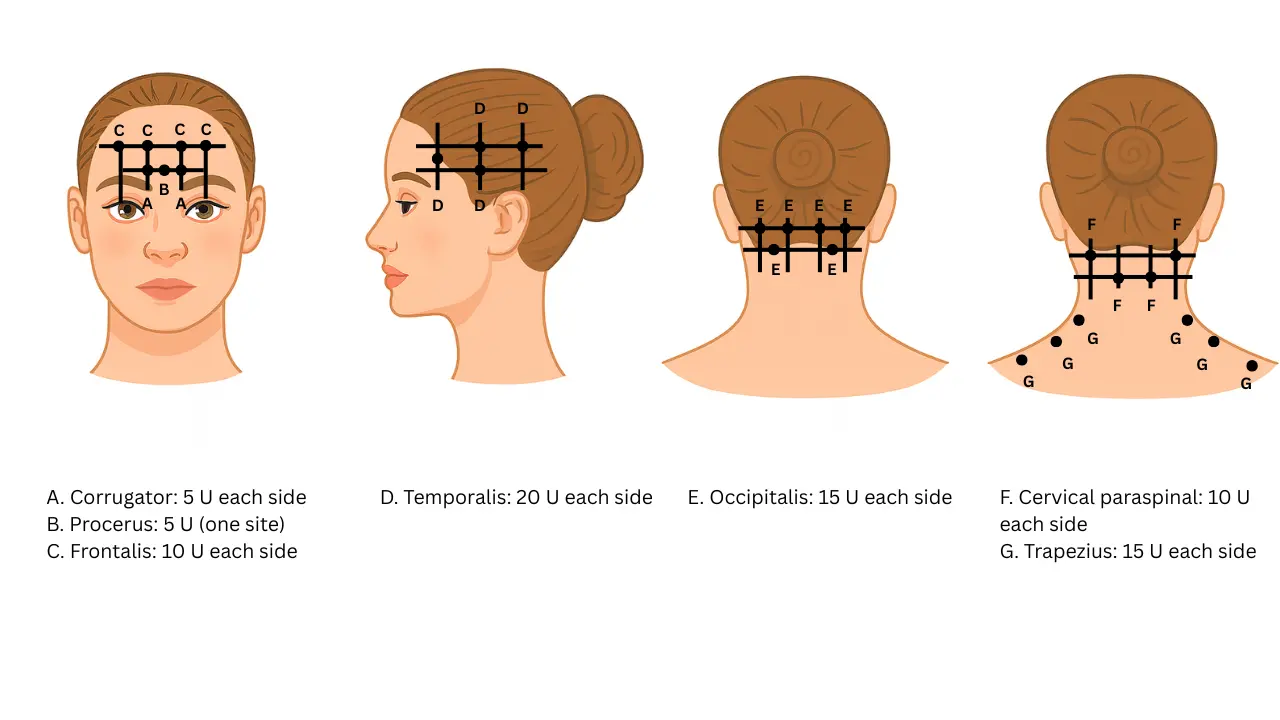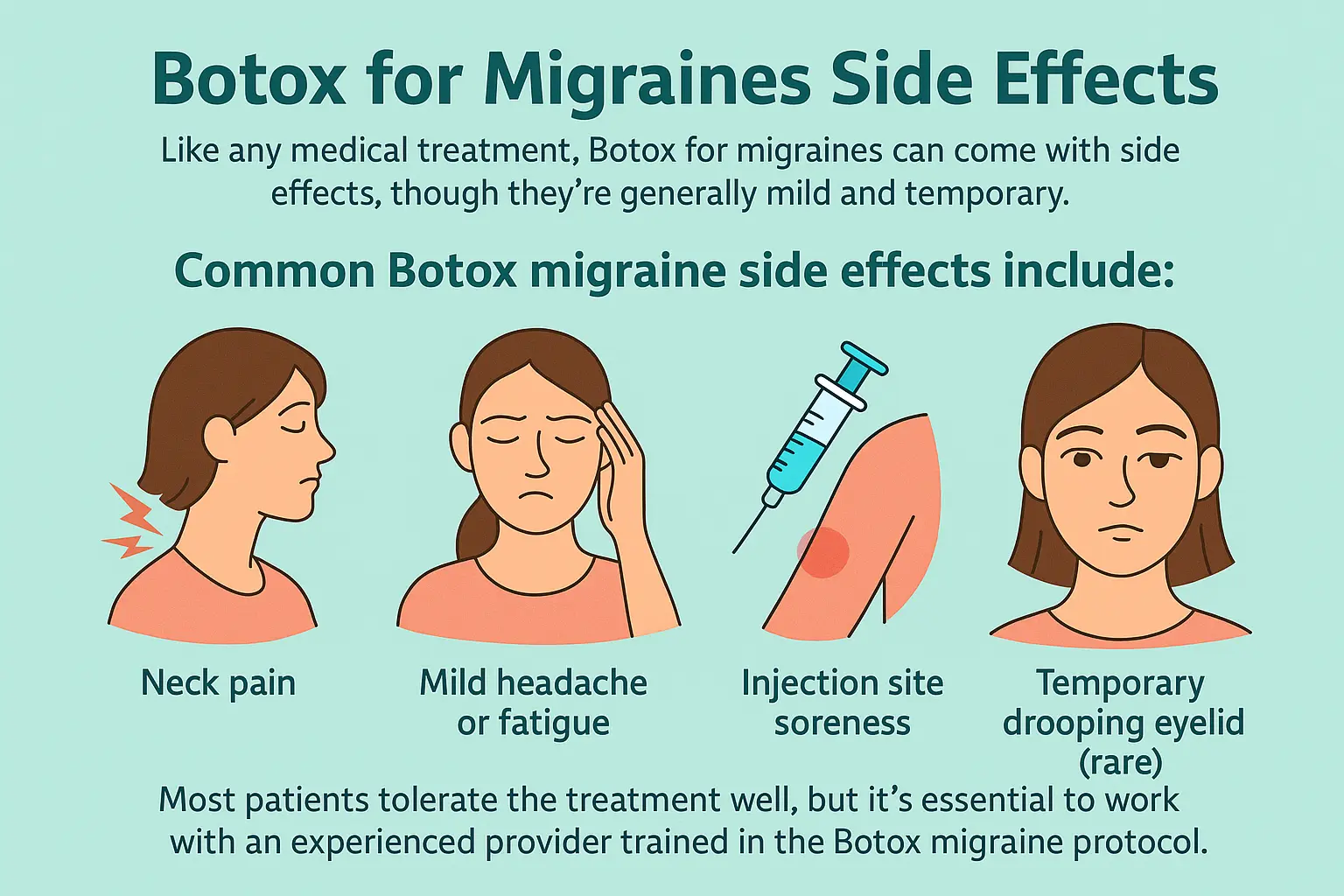
Migraines aren’t just headaches — they’re debilitating, chronic episodes that can affect your ability to function, work, and enjoy life. If you’ve tried multiple treatments with little relief, Botox for migraines might be a solution worth exploring.
This guide provides a comprehensive overview of everything you need to know about Botox and headaches, including its mechanism of action, target population, and potential outcomes.
What You Need to Know What You Need to Know
Botox, a well-known cosmetic injectable, has proven benefits beyond smoothing wrinkles. It’s FDA-approved for treating chronic migraines, offering long-lasting relief for people who suffer from headaches 15 or more days each month.
The Botox migraine protocol isn’t cosmetic — it’s a strategic medical approach aimed at reducing both the frequency and intensity of migraine attacks.
What Is Botox?
Botox is short for botulinum toxin — a purified neurotoxin that, when injected in small doses, temporarily blocks nerve signals to muscles. While it’s widely known for treating fine lines and wrinkles, it also plays a powerful role in pain management, including headache Botox treatment.
Does Botox Work for Migraine Headaches?
Yes — and it’s backed by science. Clinical studies and real-world results confirm that Botox helps migraines by reducing the number of headache days each month. Most patients begin seeing significant improvement after two to three sessions of Botox injections for migraines.
What Type of Headache Responds Best to Botox?
Botox treatments for migraines are specifically effective for chronic migraines, defined as headaches occurring 15 or more days per month, with at least 8 of those being migraine days.
Tension headaches, cluster headaches, and occasional migraines may not respond as well to Botox headache treatment, but every case is unique, so a consultation with a headache specialist is key.
How Does Botox Help Migraine Headaches?
Unlike medications that treat migraines after they start, Botox for migraines is a preventive treatment. It works by blocking the release of chemicals involved in pain transmission and preventing the activation of pain networks in the brain.
Over time, Botox migraine treatments can reduce the frequency, severity, and duration of your migraine attacks — often significantly.
Where do the injections go?

Wondering where they inject Botox for migraines? The answer is: multiple targeted sites across the head and neck.
The Botox treatment las vegas placement for migraines follows a specific protocol: 31 injections across 7 key areas, including the forehead, temples, back of the head, upper neck, and shoulders. This strategic placement is what sets migraine Botox apart from cosmetic use.
What to Expect While Getting Botox for Headaches
The Botox procedure for migraines is quick and minimally invasive. You’ll be treated in-office, with each session lasting about 15–20 minutes.
The injections may feel like tiny pinches, but most patients tolerate the treatment well. You can return to your daily activities immediately after, though there are a few things to avoid (more on that below).
Does Botox for migraines change your face?
No, Botox migraine treatment does not change your facial appearance when administered correctly. Unlike cosmetic Botox, the focus here is on Botox and migraines, not wrinkle reduction. Any minor smoothing of lines is just a bonus, not the goal.
What not to do after Botox for migraines?
Post-treatment care is simple, but important. Here’s what to avoid after your Botox shots for migraines:
- No lying down for 4 hours
- Avoid strenuous exercise for 24 hours
- Don’t rub or massage the injection areas.
These steps help prevent the Botox from migrating to unintended areas.
Botox for Migraines Side Effects

Like any medical treatment, Botox for migraines can come with side effects, though they’re generally mild and temporary.
Common Botox migraine side effects include:
- Neck pain
- Mild headache or fatigue
- Injection site soreness
- Temporary drooping eyelid (rare)
Most patients tolerate the treatment well, but it’s essential to work with an experienced provider trained in the Botox migraine protocol.
Who should not have Botox for migraine?
Botox and migraines are not for everyone. You should avoid Botox treatment for migraines if:
- You are allergic to any botulinum toxin product
- You’re pregnant or breastfeeding.
- You have a neuromuscular disorder (such as ALS or myasthenia gravis)
Always consult your healthcare provider to ensure it’s safe for your specific condition.
Does Botox for migraines cause weight gain?
No, Botox and migraines have no link to weight gain. Since Botox treatments for migraines are localized to the head and neck muscles, they don’t affect metabolism or appetite in any way.
Cost of Botox for Migraines
The cost of Botox migraine treatment varies depending on location, provider, and insurance. Without insurance, a single session can cost between $300 and $600. Since most patients need treatment every 12 weeks, it can add up, but many find the results worth it.
Does insurance cover Botox for migraines?
Yes, many insurance providers cover Botox for migraines if you meet specific criteria ,typically including:
- A diagnosis of chronic migraines
- Proof that other preventive treatments failed
- Documentation from a neurologist or headache specialist
Make sure to check with your provider to see if Botox headache treatment is included in your plan.
Conclusion
For those living with the daily burden of chronic headaches, Botox for migraines offers a real and proven path to relief. With a trusted provider and the right treatment plan, you could experience fewer migraines, reduced pain, and a better quality of life.
Whether you’re curious about Botox injections for migraines or ready to try Botox headache treatment, talk to your doctor about your options. Relief might be closer than you think.

